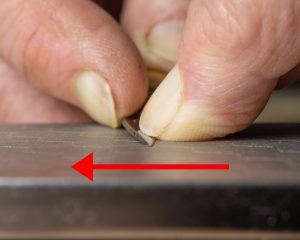
Tools for Sharpening a Knife
Methods to sharpen a carving knife seem to be quite varied, and everyone seems to have their favorite system. I have tried oil stones, ceramic stones with polishing grits, Japanese water stones, wet dry sandpaper glued to a wooden block, and diamond sharpening stones. I then use leather strops for finishing after using the various stones mentioned above. All these work very well. Presently, I am using the diamond stone and leather strop with a green polishing compound and bare leather. These take up very little room and are not messy.
The diamond stone I have has a 400 and 1000 grit, and a holder. The 400 grit is only used if there is a nick in the blade or a lot of material to remove. For most jobs the 1000 grit is sufficient following up with a strop. I lubricate the stone with a little water, then wipe it clean after use. The cutting edge for a carving knife should be 12 to 20 degrees inclusive. For flat edge blades with no bevel, all you have to do is hold the blade flat against the sharpening surface with the cutting edge trailing and tipped at the correct angle. If the blade has a bevel, the blade is tipped to have the bevel flat against the stone. Using my fingers to maintain the angle, I push the blade down the stone. The process is repeated for the other side keeping the same number of strokes for both sides. Blades that are curved are held the same way, but rotated evenly from heel to tip as it moves down t

Sharpening a Knife Blade
he stone. Once again maintaining the same number of strokes on both sides.
Many good quality carving knives come sharpened to the correct angle. Manufacturers that provide pre-sharpened tools will usually state this in their advertising. Study the blade angles on a new knife and hold them on your stone or strop with the blade angle flat against the stone or strop. This allows you to experience what the correct angle looks and feels like.
I make my own strops out of solid leather belts I get at a thrift store. I cut lengths of the belt and glue one length smooth side to a block of wood and one length rough side to the opposite side of the block. I then load up the rough leather with green polishing compound. When I strop, I use the compound side first then wipe the blade clean. I then use the smooth untreated side. I strop every 30 minutes of carving so I very seldom need the diamond stone. Over time it is possible to roll the cutting angle with stropping but a couple of passes with the diamond stone will restore the angle.
This is not the only way or necessarily the best way but it works for me.
